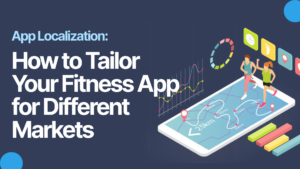Today, we’re going to dive deep into a concept that’s gaining increasing importance in the app world – app localization. Have you ever wondered why certain fitness apps just feel ‘right’ for their users, while others don’t seem to quite hit the mark?
A big part of that ‘rightness’ comes from effective app localization.
Localization is not just about translating your app into different languages. It’s about tailoring your app’s features, content, and overall user experience to fit the unique cultural context of your users.
And when we’re talking about fitness apps, localizing your product can help you resonate with your audience on a personal level. So, let’s delve into the ins and outs of app localization. Buckle up!
Table of Contents
ToggleUnderstanding App Localization
At its core, app localization is the process of adapting your app to meet the needs and preferences of users in a specific region or country. But here’s the thing – it’s about more than just translation.
Sure, translating the text into the local language is a key part of localization. But truly effective localization takes into account cultural nuances, local customs, and region-specific preferences.
Why is this so important for fitness apps, you might ask? Well, when users see content that resonates with them – content that reflects their experiences, their culture, their language – they’re more likely to engage with your app.
And more engagement means a higher chance of those users sticking around, contributing to your app’s success. This personalized user experience can help your app stand out in the ever-growing fitness app market.
The Process of Fitness App Localization
Localizing your fitness app might seem like a daunting task, but when broken down into key steps, it becomes much more manageable. Let’s go over these steps:
Translation: Start by translating all the text in your app into the local language. And we mean all – from menus and labels to workout instructions and user support messages. Remember, using professional translation services can be a huge help in this step to ensure accuracy and cultural sensitivity.
Cultural Adaptation: Next, it’s time to adapt your app’s content and features to fit the local culture. This could mean using local measurements (think miles vs. kilometers, pounds vs. kilos), incorporating local health guidelines, or featuring local fitness influencers.
The idea is to make your app feel familiar and relatable to your local users.
User Testing: Once you’ve localized your app, it’s crucial to test it with users in your target market. Their feedback will help you make sure your app is localized correctly and meets the needs of your users.
It’s a good idea to conduct regular user testing as you continue to update and improve your app.
Real-Life Examples of Fitness App Localization
It’s always beneficial to learn from the leaders in the field, right? So, let’s have a look at some fitness apps that have nailed the localization game:
Nike+ Run Club
Did you know that Nike+ Run Club has been localized for over 200 countries and regions? Apart from translating the text, Nike tailored its features to fit the local culture.
In China, for instance, the app has a leaderboard that lets users track their progress against other runners in their city. How cool is that?
Strava
This app has localized for over 100 countries and regions. Alongside language translation, Strava has incorporated features that make it resonate with local cultures.
Take India, for instance, where the app has a leaderboard tracking users’ progress against other runners in their state. A bit of friendly competition never hurt anybody, right?
Fitbit
Fitbit has localized for over 60 countries and regions. In Japan, it includes a feature allowing users to track their progress towards completing a traditional Japanese tea ceremony. How’s that for cultural relevance?
These examples illustrate how tailoring your app to the cultural and regional nuances of your target audience can be a game-changer in boosting user engagement.
Essential Tips for Successful Fitness App Localization
You’re probably thinking, “Alright, I get it, localization is crucial. But where do I start?” Don’t worry, we’ve got you covered! Here are some tips to set you on the right path:
Identify Your Target Markets: Start by figuring out who and where your potential users are. Understanding their needs and preferences will help you decide which languages and cultures to prioritize in your localization efforts.
Use Professional Translation Services: Ensure that your app’s text is translated accurately and professionally. Miscommunication or cultural insensitivity can harm your brand’s reputation, so it’s worth getting the experts involved.
Test Locally: We cannot stress this enough – always test your localized app with users in the target market. This will help you ensure that the localization is done correctly and meets your users’ needs.
Stay Current: Keep your app updated with localization changes. As your app evolves, so should the localized versions to reflect the latest updates and improvements.
Conclusion
The growing trend of app usage in the fitness industry highlights the incredible importance of app localization. It’s not just about reaching a wider audience, but about creating an app that truly connects with users on a personal level. It’s the secret ingredient that can elevate your fitness app from ‘just another app’ to ‘my go-to fitness companion’.
Remember, at Ethical Devs, we’re all about helping our clients create the best apps possible, tailor-made to engage and satisfy their users. So, start your localization journey today and get ready to conquer the fitness app world!






